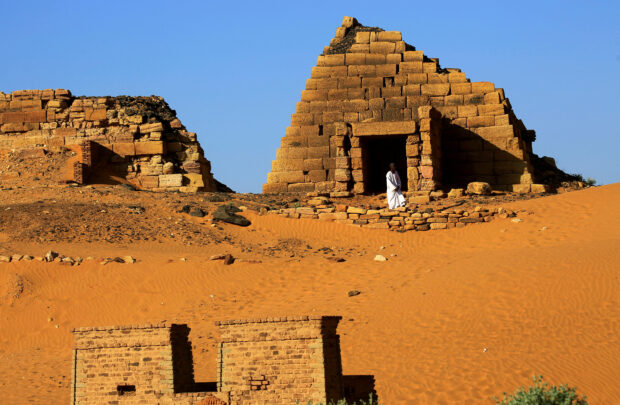
A man walks past the Royal Cemeteries of Meroe Pyramids at Begrawiya in River Nile State, Sudan, November 10, 2019. REUTERS FILE PHOTO
CAIRO — In Sudan’s capital, precious books in a major library have been burned and the national museum has been cut off for weeks by fighting. In Darfur, another museum is at risk from seasonal rains after projectiles punctured the roof.
The conflict that has been raging between rival military factions in Sudan since mid-April has taken a toll on the country’s rich cultural heritage, which includes the ancient Kingdom of Kush that controlled trade between southern Africa and Egypt at the time of the pharaohs.
Experts are scrambling to save what they can.
According to a report published last week by Heritage For Peace, a cultural heritage NGO in touch with local researchers and archaeologists, at least 28 cultural and archaeological sites around the country have been targeted or suffered collateral damage.
Some sites including several universities are being used for military purposes, according to Mahassin Yousif, an archaeologist at Bahri University.
The paramilitary Rapid Support Forces (RSF), which is locked in a power struggle with the army, released a video in early June showing their forces inside Sudan’s National Museum, which is in the centre of the capital Khartoum and houses some of the world’s oldest and most important mummies. Staff have been unable to get there to check for damage.
“There is a real problem in accessing complete information about the reality of what is happening, simply because most of these sites are within the scope of the fighting areas,” said Yousif.
Sudan has two UNESCO world heritage sites: Meroe Island, home to one of the largest ancient pyramid complexes in Africa, and Jebel Barkal, a sacred sandstone mountain close to tombs, temples and palaces that dot the course of the Nile River.
Both are in areas that are relatively calm.
“At the same time, the location has intensified chances of looting and theft,” said Ismail Hamid Nour, a Sudanese researcher at Britain’s University of Birmingham who is documenting sites at risk.
Unrest across the western region of Darfur has left at least four museums damaged, according to Heritage for Peace.
The roof of the museum in Nyala, Sudan’s second largest city and capital of South Darfur State, “has incurred minor damage from projectiles, leaving the interior vulnerable to rainfall as Sudan’s rainy season approaches”, the group reported.
The museum contains pottery, jewelry and tools that show the diversity of civilizations that once flourished in Darfur, where ethnically-motivated violence has surged again since April. It is considered one of Nyala’s main civic spaces.
Books burned
At Ahliya University in Omdurman, one of the three cities comprising Sudan’s wider capital, at least 50 rare and valuable books or collections were destroyed by fire, according to Sudan’s National Corporation of Antiquities and Museums (NCAM).
Pictures posted on social media show stacks of charred remains of books and manuscripts.
In contrast to military spending cultural preservation has long been underfunded in Sudan, Africa’s third largest by area, and local and international organizations are having to improvise.
NCAM has raised funds to pay 100 guards and inspectors to return to their posts where safe to do so, and has set up money transfers for emergency response training, measures to block illegal excavations, and teaching Darfur schoolchildren about cultural heritage.
That is part of a push to educate people about the importance of culture, without drawing attention to sites that might be targeted by armed groups trying to promote their own version of Sudan’s history, said Ibrahim Musa, NCAM’s general director.
NCAM and the International Centre for the Study of the Preservation and Restoration of Cultural Property (ICCROM) are trying to plan steps for preserving culture during the war, including the possible evacuation of artifacts.
“While there is a lot of awareness about cultural heritage and the need to protect it in times of crisis, one of our biggest challenges is that culture is still not mainstreamed into the language of humanitarian aid,” said ICCROM’s Aparna Tandon.
After Islamist rebels burned some ancient manuscripts in Timbuktu, Mali, UK-based digital humanities expert Marilyn Deegan and local researchers began a project to create a digital archive of Sudan’s cultural history.
By the time the war began, they had digitized up to 150,000 images of material dating from 4,000 BC to the 2019 uprising during which former leader Omar al-Bashir was overthrown.
But millions of items remain undigitized and at risk of being lost forever, she said. “There are radio tapes going back to the 1940s at Sudan TV. There are still lots of documentary films in the film archive. Manuscripts, books, photos, objects.”
RELATED STORIES